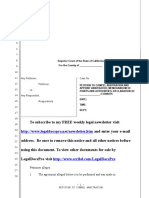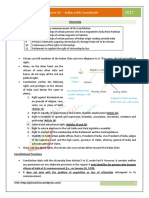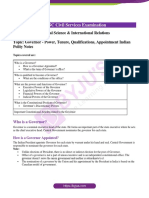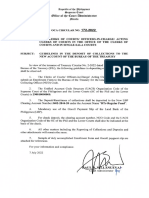0 ratings0% found this document useful (0 votes)
84 viewsAMENDMENT
AMENDMENT
Uploaded by
ShreyaThe Constitution can be amended in three ways: by a simple majority of Parliament, by a special majority of Parliament, or by a special majority of Parliament along with ratification by half of state legislatures. There have been many amendments to the Constitution over the years to change provisions, add new subjects to legislative lists, grant statehood to new states/union territories, and strengthen or repeal amendments made during emergencies. The amendments have dealt with issues like fundamental rights, legislative powers, emergency provisions, and representation of marginalized groups.
Copyright:
© All Rights Reserved
Available Formats
Download as PDF, TXT or read online from Scribd
AMENDMENT
AMENDMENT
Uploaded by
Shreya0 ratings0% found this document useful (0 votes)
84 views9 pagesThe Constitution can be amended in three ways: by a simple majority of Parliament, by a special majority of Parliament, or by a special majority of Parliament along with ratification by half of state legislatures. There have been many amendments to the Constitution over the years to change provisions, add new subjects to legislative lists, grant statehood to new states/union territories, and strengthen or repeal amendments made during emergencies. The amendments have dealt with issues like fundamental rights, legislative powers, emergency provisions, and representation of marginalized groups.
Copyright
© © All Rights Reserved
Available Formats
PDF, TXT or read online from Scribd
Share this document
Did you find this document useful?
Is this content inappropriate?
The Constitution can be amended in three ways: by a simple majority of Parliament, by a special majority of Parliament, or by a special majority of Parliament along with ratification by half of state legislatures. There have been many amendments to the Constitution over the years to change provisions, add new subjects to legislative lists, grant statehood to new states/union territories, and strengthen or repeal amendments made during emergencies. The amendments have dealt with issues like fundamental rights, legislative powers, emergency provisions, and representation of marginalized groups.
Copyright:
© All Rights Reserved
Available Formats
Download as PDF, TXT or read online from Scribd
Download as pdf or txt
0 ratings0% found this document useful (0 votes)
84 views9 pagesAMENDMENT
AMENDMENT
Uploaded by
ShreyaThe Constitution can be amended in three ways: by a simple majority of Parliament, by a special majority of Parliament, or by a special majority of Parliament along with ratification by half of state legislatures. There have been many amendments to the Constitution over the years to change provisions, add new subjects to legislative lists, grant statehood to new states/union territories, and strengthen or repeal amendments made during emergencies. The amendments have dealt with issues like fundamental rights, legislative powers, emergency provisions, and representation of marginalized groups.
Copyright:
© All Rights Reserved
Available Formats
Download as PDF, TXT or read online from Scribd
Download as pdf or txt
You are on page 1of 9
How Can Constitution Be Amended?
The Constitution can be amended in three ways:
1. Amendment by a simple majority of the Parliament.
2. Amendment by a special majority of the Parliament.
3. Amendment by a special majority of the Parliament and the ratification of half of
the state legislature.
IMPORTANT AMENDMENTS TO CONSTITUTION
First Amendment Act, 1951
1. Empowered the state to make the advancement of socially and economically
backward classes.
2. Provided for the saving of laws providing for the acquisition of estates etc.
3. Added 9th Schedule to protect the land reform and other laws included in it from
the judicial review.
4. Added three more grounds of restrictions on freedom of speech and expression,
viz., public order, friendly relations with foreign states and incitement to an offence.
It also made the restrictions ‘reasonable’ and thus, justifiable in nature.
5. Provided that state trading and nationalisation of any trade or business by the
state is not to be invalid on the ground of violation of the right to trade or business.
The Constitution (6th Amendment) Act, 1956
1. Included a new subject in the Union list i.e., taxes on the sale and purchase of
goods in the course of inter-state trade and commerce and restricted the state’s
power in this regard.
Constitutional (8th Amendment) Act,1960
1. It Extended the period of reservation of seats for the Scheduled Castes and
Scheduled Tribes and Anglo-Indians in the Lok Sabha and the State Legislative
Assemblies till 1970.
2. It Amended article 334 of the constitution.
Constitutional (10th Amendment) Act, 1961
1. Incorporation of Dadra, Nagar and Haveli as a Union Territory, consequent to
acquisition from Portugal.
2. It amended article 240 of the constitution.
Constitutional (13th Amendment) Act,1963
1. Formation of State of Nagaland, with special protection under Article 371A.
2. It amended article 170.
Constitutional (15th Amendment)Act, 1963
1. Enabled the High court’s to issue writs to any person or authority even outside
its terrorist’s jurisdiction if the cause of action arises within its territorial
limits.
2. Increased the retirement age of high court judges from 60 to 62 years.
3. Provided for the appointment of retired judges of the high court’s as acting
judges of the same court.
4. Provided the compensatory allowance to judges who are transferring from
one High court to another.
5. Enabled the retired judge of the High Court to act as ad-hoc judge of the
Supreme Court.
6. Provided for the procedure for determining the age of the Supreme Court and
High Court judges.
The Constitution (24th Amendment) Act, 1971
1. Affirmed the power of Parliament to amend any part of the Constitution
including Fundamental Rights.
2. Made it compulsory for the president to give his assent to a constitutional
Amendment Bill.
The Constitution (31st Amendment) Act, 1973
1. Increased the elective strength of the Lok Sabha from 525 to 545. Under the
Act, the upper limit of representatives of the States goes up from 500 to 525
and that of the Union Territories decreases from 25 to 20.
The Constitution (36th Amendment) Act, 1975
1. By this Act, Sikkim became the 22nd State of the Indian Union.
The Constitution (37th Amendment) Act, 1975
1. It was passed by Parliament on April 26, 1975, to provide for a Legislative
Assembly and a Council of Ministers to Arunachal Pradesh, the country’s
north-easternmost Union Territory.
The Constitution (39th Amendment) Act, 1975
1. The Bill was passed by the Lok Sabha on August 7 and received Presidential
assent on August 9, 1975.
2. The Act places beyond challenge in courts the election to Parliament of a person
holding the office of Prime Minister or Speaker and the election of President and
Vice-President.
The Constitution (40th Amendment) Act, 1976
1. Empowered the Parliament to specify from time to time the limits of the territorial
waters, the continental shelf, the Exclusive Economic Zone (EEZ) and the maritime
zones of India.
2. Included 64 more Central and state laws, mostly relating to land reforms, in the
9th Schedule.
The Constitution (42nd Amendment) Act, 1976
1. It was enacted during the period of internal emergency. It was passed by
Parliament on November 11, 1976 and received Presidential assent on December 18,
1976.
2. The Amendment established beyond doubt the supremacy of Parliament over the
other wings of Government; gave the Directive Principles precedence over
the Fundamental Rights; enumerated for the first time a set of ten Fundamental
Duties.
3. It further imposed limits on the power and jurisdiction of the judiciary; raised the
term of the Lok Sabha and the Vidhan Sabha from five to six years; authorised the
use of Central armed forces in any State to deal with law and order problems, made
the President bound by the advice of the Council of Ministers and envisaged the
establishment of administrative tribunals for service matters of Government
employees and also other tribunals for economic offences.
4. The Act also clearly laid down that no Constitutional Amendment could be
questioned in any court of law.
The Constitution (43rd Amendment) Act, 1978
1. It received the Presidential assent on April 13, 1978.
2. This Act repeals the obnoxious provisions of the Constitution (42nd Amendment)
Act passed during the Emergency. It restores civil liberties by deleting Article 3ID
which gave powers to Parliament to curtail even legitimate trade union activity under
the guise of legislation for the prevention of anti-national activities.
3. The new law, which was ratified by more than half of the States in accordance
with the Constitution, also restores legislative powers to the States to make
appropriate provision for anti-national activities consistent with the Fundamental
Rights. Under the Act, the judiciary has also been restored to its rightful place.
4. The Supreme Court will now have the power to invalidate state laws, a power
taken away by the 42nd Amendment Act. The High Courts will also be able to go into
the question of the constitutional validity of Central laws thereby enabling persons
living in distant places to obtain speedy justice without having to come to the
Supreme Court.
The Constitution (44th Amendment) Act, 1978
1. The Constitution (45 th Amendment) Bill, re-numbered as the 44th Amendment
came into force on April 30, 1979, when the President gave his assent.
2. The Act removes major distortions in the Constitution introduced during the
Emergency. The duration of the Lok Sabha and State Legislative Assemblies has
been reduced from six to five years—the normal term which was extended during the
Emergency under the 42nd Amendment to achieve some political purposes.
3. The Right to Property ceases to be a Fundamental Right and becomes only a legal
right according to the Constitution 44th Amendment.
4. The Act also extends, for the first time since independence, constitutional
protection for publication of the proceedings of Parliament and State Legislatures,
except in cases where it is proved to be “malicious”. Another important feature of the
Act is that any proclamation of Emergency needs henceforward, be issued by the
President only after receiving the advice of the Cabinet as a whole in writing. The
President will not be called upon to act on the basis of advice by the Prime Minister
on his own without consulting his Cabinet. Other safeguards provide that the
proclamation will have to be adopted by a two-thirds majority of the members of
both Houses of Parliament within a month.
5. The 44th Amendment provides safeguards against future subversion of the
Constitution for establishing an authoritarian regime. It contains provisions that are
designed to make it impossible to impose the kind of emergency the country had
experienced for 19 months.
The Constitution (45th Amendment) Act, 1980
1. The Act extends reservation of seats for the Scheduled Castes and the Scheduled
Tribes in Parliament and the State Assemblies and the representation of Anglo-
Indians by the nomination for a further period of 10 years.
The Constitution (46th Amendment) Bill, 1982
1. It seeks to authorise the government to prepare an authoritative text of the
Constitution, in Hindi.
The Constitution (52nd Amendment) Act, 1985
1. The Act has made defection to another party, after elections illegal. Any member
defecting to another party after elections will be disqualified from being Member
of Parliament or State Legislature.
The Constitution (53rd Amendment) Act, 1986
1. It confers Statehood on Mizoram and ensures against unnecessary interference
by the Central Government with the laws relating to spheres of social relationship
and community conduct applicable to Mizoram.
The Constitution (54th Amendment) Act, 1986
1. It enhances the salaries of Judges of the High Courts and Supreme Court of
India. The salary of Chief Justice of India will be Rs 10,000; Chief Justice of High
Courts Rs 9000; Judges of Supreme Court Rs 9000; and Judges of High Courts Rs
8000.
The Constitution (55th Amendment) Act, 1987
1. It grants Statehood to Arunachal Pradesh which consequently became the 24th
State of the Indian Union.
The Constitution (56th Amendment) Act, 1987
1. It confers Statehood on Goa and forms a new Union Territory of Daman and Diu.
Goa thus became the 25th State of the Indian Republic.
The Constitution (57th Amendment) Act, 1987
1. It made a special provision for the setting up of the new State of Goa.
Consequently Daman and Diu were separated from the former to form a Union
Territory.
The Constitution (58th Amendment) Act, 1988
1. It provides for special arrangements with regard to reservation of seats for
Scheduled Tribes in the States of Arunachal Pradesh, Nagaland, Mizoram and
Meghalaya. By amending Article 322 the adjustment of seats has been frozen until
2000 A.D.
The Constitution (59th Amendment) Act, 1988
1. It empowered the Central Government to impose Emergency in Punjab when
deemed necessary. Under the amendment, the President’s rule can be extended up
to three years. The earlier maximum period was two years.
The Constitution (61st Amendment) Act, 1989
1. It lowered the voting age from 21 to 18.
The Constitution (62nd Amendment) Act, 1989
1. It provided for the extension by another 10 years of reservation of seats in the
Parliament and State Assemblies for the Scheduled Castes and Tribes and
reservation for the Anglo Indian community by nomination.
The Constitution (63rd Amendment) Act, 1989
1. It repealed Amendment 59 which empowered the government to impose
emergency in Punjab.
The Constitution (64th Amendment) Act, 1990
1. It extended the President’s rule in Punjab by six months.
The Constitution (66th Amendment) Act, 1990
1. To bring land reforms within the purview of 9th Schedule of the
Constitution.
The Constitution (69th Amendment) Act, 1991
1. Delhi made National Capital Region. The Act also made provision for Legislative
assembly and a council of ministers for Delhi.
The Constitution (70th Amendment) Act, 1992
1. Before this act was made Article 54 relating to the election of the President
provided for an electoral college consisting only of the elected members of
Parliament as well as the legislative assemblies of the States (not of Union
Territories). The amendment provides for the inclusion of members of the legislature
of Pondicherry and Delhi.
The Constitution (71st Amendment) Act, 1992
1. The act amends the 8th Schedule to the Constitution to include Konkani, Manipuri
and Nepali Languages in the 8th Schedule of the Constitution.
The Constitution (72nd Amendment) Act, 1992
1. To make temporary provision for the determination of the number of seats
reserved for the Scheduled Tribes in the State assembly of Tripura, until the re-
adjustment of seats is made on the basis of the first census after the year 2000
under article 170 of the Constitution.
The Constitution (73rd Amendment) Act, 1992
1. To ensure direct election to all seats in Panchayats; to reserve seats for SCs and
STs in proportion to their population; and for reservation of not less than one-third of
the seats in Panchayats for women.
The Constitution (74th Amendment) Act, 1992
1. It was made to ensure direct election to all seats in Nagarpalikas and
Municipalities.
The Constitution (75th Amendment) Act 1994
1. It provides for setting up of State-level Rent Tribunals to exclude the jurisdiction of
all courts, except that of the Supreme Court, under Article 136 of the Constitution.
The Constitution (76th Amendment) Act, 1994
1. It relates to the Reservation of Seats in Educational Institutes and of
appointments or posts in the Services under a State, for Backward Classes,
Scheduled Castes and Scheduled Tribes. The Supreme Court had ruled on November
16, 1992, that the total reservations under Article 16(40) of the Constitution should
not exceed 50 percent.
The Constitution (77th Amendment) Act, 1995
1. According to this Act, the Government has decided to continue the existing policy
of reservation in promotion for the Scheduled Castes and Scheduled Tribes.
The Constitution (78th Amendment) Act, 1995
1. It includes land reform laws in the Ninth Schedule so that they cannot be
challenged before the courts.
The Constitution (79th Amendment) Act, 1999
1. It extends the reservation of seats for SC, ST and Anglo-Indians in the Lok Sabha
and Legislative Assemblies for the next 10 years.
The Constitution (80th Amendment) Act, 2000
1. It deals with an alternative scheme for sharing taxes between the Union and the
States.
The Constitution (81st Amendment) Act, 2000
1. It provides that the unfilled vacancies of a year reserved for SC/ST kept for being
filled up in a year as per Article 16, shall be considered separately for filling
vacancies in the succeeding year and the previous list will not be considered for
filling the 50% quota of the respective year.
The Constitution (82nd Amendment) Act, 2000
1. It provides that nothing in Article 355 shall prevent the State from making any
provisions in favour of the members of SC/ST for relaxation in qualifying marks with
respect to examination/job/promotion.
The Constitution (83rd Amendment) Act, 2000
1. The Act amended Article 243 M to provide that no reservation in Panchayats be
made in favour of SC/ST in Arunachal Pradesh where the whole population is tribal.
The Constitution (84th Amendment) Act, 2001
1. Extended ban on the readjustment of seats in the Lok Sabha and the state
legislature assemblies for another 25 years (i.e., up to 2026) with the same objective
of encouraging population limiting measures.
The Constitution (85th Amendment) Act, 2001
1. Provided for ‘consequential seniority in the case of promotion by the virtue of rule
of reservation for the government servants belonging to the SCs and STs with
retrospective effect from June 1995.
The Constitution (86th Amendment) Act, 2002
1. Provides the Right to Education until the age of fourteen and early childhood care
until the age of six.
The Constitution (87th Amendment) Act, 2003
1. Provided for readjustment and rationalisation of territorial constituencies in the
states on the basis of the population figures of the 2001 census and not the 1991
census as provided earlier by the 84th Amendment Act of 2001.
The Constitution (88th Amendment) Act, 2003
1. Made provision for service tax (Article 268-A)
The Constitution (89th Amendment) Act, 2003
1. Bifurcated the erstwhile combined National Commission for Scheduled Castes
and Scheduled Tribes into two separate bodies, namely, National Commission of
SCs (Article- 338) and National Commission of STs (338-A).
The Constitution (90th Amendment) Act, 2003
1. Provided for maintaining the erstwhile representation of the Scheduled Tribes in
the Assam legislative assembly from the Bodoland Territorial Areas District (Article-
332 (6))
The Constitution (91st Amendment) Act, 2004
1. Restricted the size of the Council of Ministers (CoM) to 15 percent of legislative
members & strengthened the Anti Defection laws.
The Constitution (92nd Amendment) Act, 2004
1. Included Bodo, Dogri, Santali and Maithali as official languages.
The Constitution (93rd Amendment) Act, 2006
1. Provided for 27 percent reservation for other backward classes in government as
well as private higher educational institutions.
The Constitution (94th Amendment) Act, 2006
1. To provide for a Minister of Tribal Welfare in newly created Jharkhand and the
Chhattisgarh States including Madhya Pradesh and Orissa.
The Constitution (95th Amendment) Act, 2010
1. To extend the reservation of seats for Scheduled Castes (SCs) and Scheduled
Tribes (STs) in the Lok Sabha and states assemblies from Sixty years to Seventy
years
The Constitution (96th Amendment) Act, 2011
1. Substituted Odia for Oriya
The Constitution (97th Amendment) Act, 2012
1. Added the words "or co-operative societies" after the word "or unions" in Article
19(l) (c) and inserted article 43B related to the promotion of co-operative societies
and added Part-IXB that is The Co-operative Societies.
The Constitution (98th Amendment) Act, 2013
1. To empower the Governor of Karnataka to take steps to develop the Hyderabad-
Karnataka Region.
The Constitution (99th Amendment) Act, 2014
1. The amendment provides for the formation of a National Judicial Appointments
Commission.
The Constitution (100th Amendment) Act, 2015
1. The term the Constitution (100th Amendment) Act, 2015 was in news in the fourth
week of May 2015 as the President of India Pranab Mukherjee gave his assent to the
Constitution (119th Amendment) Bill, 2013 that related to the Land Boundary
Agreement (LBA) between India and Bangladesh.
The Constitution (101th Amendment) Act,2017: Introduced the Goods and Services
Tax in the country since 1 July 2017.
The Constitution (102th Amendment) Act,2018: It gave Constitutional status to
National Commission for Backward Classes.
The Constitution (103th Amendment) Act,2019: It provided a maximum of 10%
Reservation for Economically Weaker Sections (EWSs).
The Constitution (104th Amendment) Act,2020: It extended the reservation of seats
for SCs and STs in the Lok Sabha and states assemblies.
So, till date, there are 104 amendments have been made in the Indian Constitution
since its inception in 1950.
You might also like
- Motion For Early Termination of Supervised Release 2012 PDFDocument5 pagesMotion For Early Termination of Supervised Release 2012 PDFRicardo SuarezNo ratings yet
- Sample Petition To Compel Arbitration For CaliforniaDocument2 pagesSample Petition To Compel Arbitration For CaliforniaStan Burman40% (5)
- Important Constitutional AmendmentsDocument6 pagesImportant Constitutional AmendmentsAAYUSH SAXENANo ratings yet
- Important Amendments in Indian Constituion - ClatDocument10 pagesImportant Amendments in Indian Constituion - ClatSharvi SharmaNo ratings yet
- Important Amendments To The ConstitutionDocument6 pagesImportant Amendments To The ConstitutionprinceNo ratings yet
- 1 Year Plan For CSE 2024Document31 pages1 Year Plan For CSE 2024Prasad PatilNo ratings yet
- M7 La Ex RRP (Prelims) Environment Ready ReckonerDocument91 pagesM7 La Ex RRP (Prelims) Environment Ready ReckonerSateeshNo ratings yet
- Important Themes of Indian ConstitutionDocument59 pagesImportant Themes of Indian ConstitutionKunal BazalaNo ratings yet
- 01Document27 pages01DDNo ratings yet
- Preamble Declares India To Be A Sovereign, Socialist, Secular and Democratic RepublicDocument8 pagesPreamble Declares India To Be A Sovereign, Socialist, Secular and Democratic RepublicPpriya PNo ratings yet
- 3 - Polity by DR Sidharth Arora - 3 - Fundamental Rights-FrDocument300 pages3 - Polity by DR Sidharth Arora - 3 - Fundamental Rights-FrNishant SinghNo ratings yet
- Odisha SDC A2Document35 pagesOdisha SDC A2Vurimi BhuvaneswareNo ratings yet
- PolityDocument62 pagesPolitySubhangi PodderNo ratings yet
- Important Amendments in Indian ConstitutionDocument7 pagesImportant Amendments in Indian Constitutionkrishnasantana1988No ratings yet
- Exampification EssayDocument20 pagesExampification EssayAkonyaNo ratings yet
- Constitution Questions in UPSC Mains GS 1 2013 2021Document3 pagesConstitution Questions in UPSC Mains GS 1 2013 2021PulikeshiNo ratings yet
- British Indian ActsDocument3 pagesBritish Indian ActsSenthil PrabhuNo ratings yet
- Important Constitutional Amendments - Mains Marks BoosterDocument30 pagesImportant Constitutional Amendments - Mains Marks BoosterAman Chouhan100% (1)
- Class XII 1Document71 pagesClass XII 1Atul KumarNo ratings yet
- NnnppppaaaaDocument33 pagesNnnppppaaaayashuyash33No ratings yet
- Constituent Assembly of IndiaDocument7 pagesConstituent Assembly of IndiaLawrence JowittNo ratings yet
- Gs 2 DecodedDocument9 pagesGs 2 DecodedOwais MalikNo ratings yet
- Indian ConstitutionDocument120 pagesIndian ConstitutionNilabh KumarNo ratings yet
- Day 1 Quick Revision Polity 120 Days Upsc Perlims 2021 10pointerDocument8 pagesDay 1 Quick Revision Polity 120 Days Upsc Perlims 2021 10pointerAllindiatestNo ratings yet
- IntegrityDocument6 pagesIntegrityRanaNo ratings yet
- Polity Short NotesDocument15 pagesPolity Short NotesUmar AnsariNo ratings yet
- ESSAY CLASS - Upsc NotesDocument2 pagesESSAY CLASS - Upsc NotesVedansh ShuklaNo ratings yet
- Mrunal (Polity) 2nd ARC - Ethics and Corruption (4th Report) - Election Reforms, State Funding of Elections MrunalDocument15 pagesMrunal (Polity) 2nd ARC - Ethics and Corruption (4th Report) - Election Reforms, State Funding of Elections MrunalmegakiranNo ratings yet
- Write A Note On Salient Features and Characteristics of The Constitution of IndiaDocument41 pagesWrite A Note On Salient Features and Characteristics of The Constitution of IndiaSuryateja GittaNo ratings yet
- Rau's IAS Focus Magazine March 2020 @UPSC - THOUGHTS PDFDocument128 pagesRau's IAS Focus Magazine March 2020 @UPSC - THOUGHTS PDFVikasNo ratings yet
- POLITY EngDocument119 pagesPOLITY EngMayank MangalNo ratings yet
- Chanakya Mandal Pariwar: Beginner's Guide To UPSCDocument23 pagesChanakya Mandal Pariwar: Beginner's Guide To UPSCAtishNo ratings yet
- Important Articles of The Indian ConstitutionDocument5 pagesImportant Articles of The Indian ConstitutionUdit PandeyNo ratings yet
- IPR-II Module 5Document29 pagesIPR-II Module 5Mahadev HakeNo ratings yet
- Indian ConstitutionDocument81 pagesIndian ConstitutionSayantan HatiNo ratings yet
- The Composition and Working of The Constituent AssemblyDocument6 pagesThe Composition and Working of The Constituent AssemblyArunachalam RNo ratings yet
- Geography and Its Aspects and Impact On Our DailylifeDocument292 pagesGeography and Its Aspects and Impact On Our DailylifeShreyaNo ratings yet
- Indian Polity GIST of NCERTDocument26 pagesIndian Polity GIST of NCERTssingh_scribdNo ratings yet
- Biology and Basic ScienceDocument37 pagesBiology and Basic ScienceayushNo ratings yet
- Environment Terminologies RRP 2022Document59 pagesEnvironment Terminologies RRP 2022Nithin SindheNo ratings yet
- General KnowledgeDocument123 pagesGeneral KnowledgeSardar Muhammad FahadNo ratings yet
- Pinnacle IAS - Indian Polity Laxmikanth: CitizenshipDocument4 pagesPinnacle IAS - Indian Polity Laxmikanth: Citizenshipshaheer001100% (1)
- (Topper's Interview) Rajarshi Raj Varma (UPSC-2013 - Rank-351) - First Attempt, Public Administration, Ranchi, XIM-Bhubaneswar - MrunalDocument41 pages(Topper's Interview) Rajarshi Raj Varma (UPSC-2013 - Rank-351) - First Attempt, Public Administration, Ranchi, XIM-Bhubaneswar - MrunalApurva Shukla100% (1)
- Welfare StateDocument12 pagesWelfare StateAwais AbidNo ratings yet
- Sectors of The Indian Economy - Class Notes - Foundation Mind-MapDocument67 pagesSectors of The Indian Economy - Class Notes - Foundation Mind-Mapnimit jaiswalNo ratings yet
- Polity Chpater - 01 To 05 Notes emDocument147 pagesPolity Chpater - 01 To 05 Notes emnishanthi.nukalaNo ratings yet
- Study Material Working of InstitutionDocument20 pagesStudy Material Working of InstitutionAarushNo ratings yet
- 7 HistoryDocument83 pages7 Historynavam singhNo ratings yet
- TSPSC Group 2 SyllabusDocument8 pagesTSPSC Group 2 SyllabusVaahnikaNo ratings yet
- Ias BookmarksDocument29 pagesIas BookmarksDr-Jitendra VaishNo ratings yet
- Flash Polity March 2024Document71 pagesFlash Polity March 2024karangaur6751No ratings yet
- Governor Indian Polity Notes PDFDocument5 pagesGovernor Indian Polity Notes PDFsanjayrakshita100% (1)
- Rau's Mains Compass 2021 Ethics, Integr & AptitDocument137 pagesRau's Mains Compass 2021 Ethics, Integr & AptitAditya AmbasthaNo ratings yet
- Physical Geography G.S. I - Ed2a02f9 9b37 4dcd 8929 Fe4b8914b19bDocument97 pagesPhysical Geography G.S. I - Ed2a02f9 9b37 4dcd 8929 Fe4b8914b19bAmir RashidNo ratings yet
- Parts of The Indian ConstitutionDocument10 pagesParts of The Indian Constitutionserryserry362No ratings yet
- UPSC Personality TestDocument41 pagesUPSC Personality TestStephanie LucasNo ratings yet
- Important Constitutional AmendmantsDocument4 pagesImportant Constitutional AmendmantsShiva Shankar PandianNo ratings yet
- Constitution AmendmentsDocument6 pagesConstitution Amendmentssahulala793No ratings yet
- List of Important Amendments of The Indian ConstitutionDocument7 pagesList of Important Amendments of The Indian ConstitutionpreetamdasNo ratings yet
- The Constitution of India Amendment Procedure and Some Important Amendments (Part I)Document2 pagesThe Constitution of India Amendment Procedure and Some Important Amendments (Part I)ishk1989No ratings yet
- GS Score - MAJOR - AMENDMENTS - TO - THE - CONSTITUTIONDocument20 pagesGS Score - MAJOR - AMENDMENTS - TO - THE - CONSTITUTIONnoorbashaumarNo ratings yet
- AMENDMENTS TO CONSTIDocument7 pagesAMENDMENTS TO CONSTIteyesolomon590No ratings yet
- Parayno Vs MenesesDocument3 pagesParayno Vs MenesesJazem AnsamaNo ratings yet
- Evidence Scope of The Rules of EvidenceDocument9 pagesEvidence Scope of The Rules of EvidenceAice ManalotoNo ratings yet
- 911 Notify v. Carshield ServicesDocument5 pages911 Notify v. Carshield ServicesPriorSmartNo ratings yet
- Late Filing of Position Paper Re: RSP (Jurisprudence)Document2 pagesLate Filing of Position Paper Re: RSP (Jurisprudence)Krieg Dustin Mac MengoteNo ratings yet
- WEAC BylawsDocument33 pagesWEAC BylawsdespaNo ratings yet
- Flipkart Labels 27 Jun 2021 06 53Document1 pageFlipkart Labels 27 Jun 2021 06 53h4ckerNo ratings yet
- Titles of Nobility by MarchDocument157 pagesTitles of Nobility by MarchMichelleNo ratings yet
- Memorial For The ProsecutionDocument40 pagesMemorial For The ProsecutionArzoo khanNo ratings yet
- Sample Motion To Compel Responses To Requests For Production of DocumentsDocument3 pagesSample Motion To Compel Responses To Requests For Production of DocumentsStan Burman50% (2)
- Saluday vs. PeopleDocument4 pagesSaluday vs. PeopleMaestro Lazaro100% (4)
- TITLE 8 Criminal Law II Case Digests The Revised Penal CodeDocument16 pagesTITLE 8 Criminal Law II Case Digests The Revised Penal CodegabbieseguiranNo ratings yet
- OCA Circular No. 172-2022Document3 pagesOCA Circular No. 172-2022Arnel CaparrosNo ratings yet
- Order in Respect of Kesar Petro Products LimitedDocument8 pagesOrder in Respect of Kesar Petro Products LimitedShyam SunderNo ratings yet
- G.R. No. 131012 April 21, 1999 Gloria Vs CoaDocument5 pagesG.R. No. 131012 April 21, 1999 Gloria Vs CoajericglennNo ratings yet
- CD - 4. Melecio Domingo V Hon GarlitosDocument1 pageCD - 4. Melecio Domingo V Hon GarlitosCzarina CidNo ratings yet
- Sting Operations: The Role of Media As A Vigilante: Ahkam Khan & Parimal KashyapDocument12 pagesSting Operations: The Role of Media As A Vigilante: Ahkam Khan & Parimal KashyapSimran GahuniaNo ratings yet
- RULE 113 - Villanueva v. PeopleDocument2 pagesRULE 113 - Villanueva v. PeoplebeaenriquezNo ratings yet
- Modes of Rectification of Instrument: FraudDocument9 pagesModes of Rectification of Instrument: Fraudanuyadav852No ratings yet
- GST LITIGATION & Appeal CA Sandeep SachdevaDocument57 pagesGST LITIGATION & Appeal CA Sandeep Sachdevapramodmurkya13No ratings yet
- Law of Crimes IDocument127 pagesLaw of Crimes ISwamy MvmNo ratings yet
- Table of FIDIC CasesDocument72 pagesTable of FIDIC CasesBosZ Anderson100% (1)
- Obstruction of JusticeDocument8 pagesObstruction of JusticeRey RectoNo ratings yet
- Cebu State College v. MisterioDocument12 pagesCebu State College v. MisterioErnesto Naval IIINo ratings yet
- Digest 1-8Document9 pagesDigest 1-8Yui RecintoNo ratings yet
- Booking Report 6-23-2020Document3 pagesBooking Report 6-23-2020WCTV Digital Team0% (1)
- Sbs Ex Parte Application Dec Re NoticeDocument4 pagesSbs Ex Parte Application Dec Re Noticejsmendez1719No ratings yet
- Buyco vs. RepublicDocument4 pagesBuyco vs. Republicmerren bloomNo ratings yet
- Canons 1-3Document53 pagesCanons 1-3Shawn LeeNo ratings yet

























































































